Examining Supply Chain Management Functions and Globalization Effects
VerifiedAdded on 2023/04/03
|15
|2778
|353
Report
AI Summary
This report provides a comprehensive analysis of supply chain management, focusing on its key functions, the impact of globalization, and the challenges organizations face in maintaining effective global supply chains. It examines the evolution of supply chain management over the past decade, highlighting the integration of companies through Enterprise Resource Planning (ERP) systems, the role of technology in enhancing collaboration and order tracking, and the factors that have contributed to the globalization of supply chains. The report also addresses issues such as payment delays, government policies, cultural differences, and the rising need for modern supply chain practices to adapt to the fast-changing global market. It concludes by recommending strategies for improving global supply chain operations.
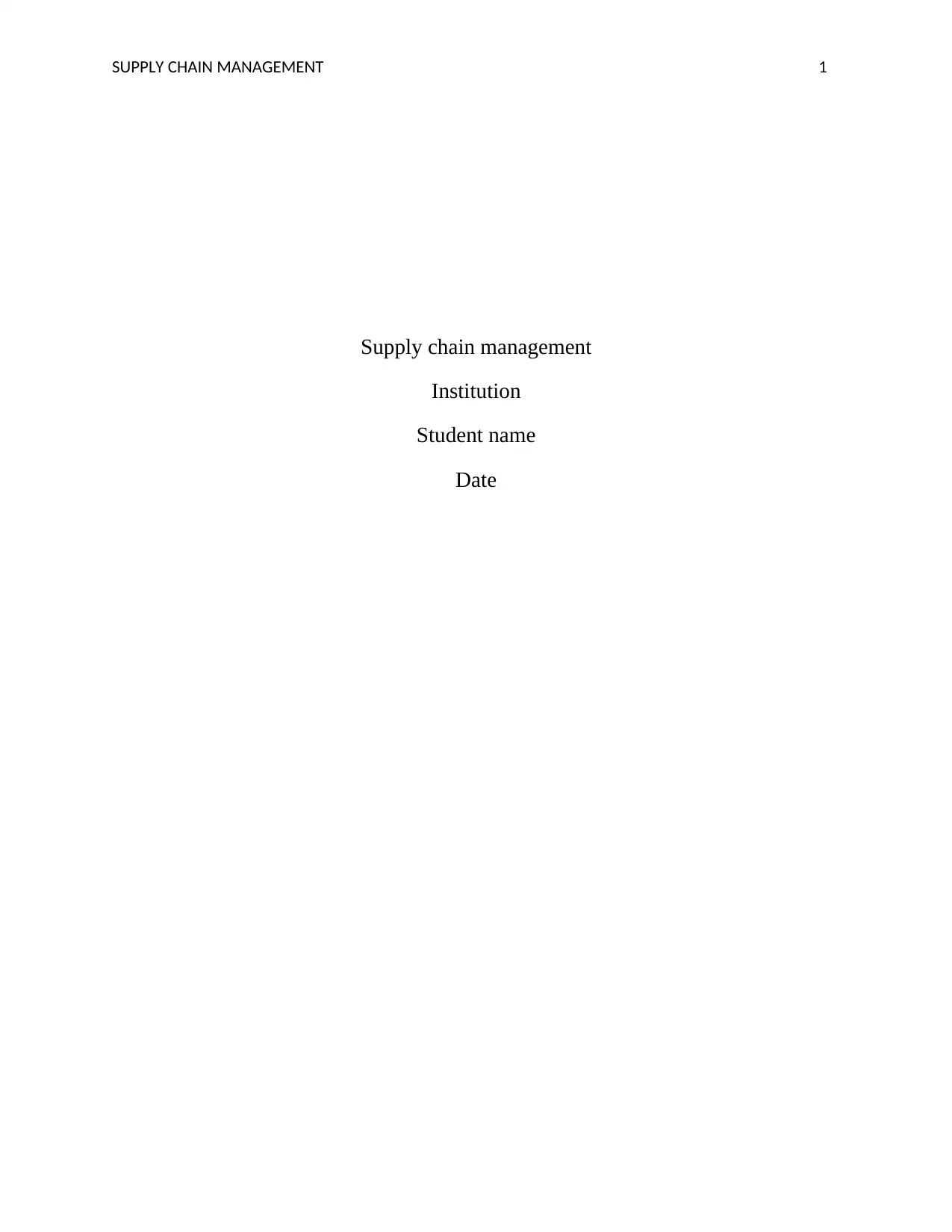
SUPPLY CHAIN MANAGEMENT 1
Supply chain management
Institution
Student name
Date
Supply chain management
Institution
Student name
Date
Paraphrase This Document
Need a fresh take? Get an instant paraphrase of this document with our AI Paraphraser

SUPPLY CHAIN MANAGEMENT 2
Executive summary
The purpose of this report is to outline and analyze the critical functions and the main
activities linked to supply chain management as well as the effects of globalization in the current
world. Further, the report analyzes the challenges of the organization that operates in the global
environment and the difficulty of instantiating and maintaining an effective supply chain
management.
The report in this article is confined in the limits of the activities carried out in the supply
chain management in the current world and the challenges the organizations suffer in the process
globally.
The report is based on the information and data collected in about the last decade for the
effectiveness in time to be termed as modern. This is done in appreciation of the trends in supply
chain management globally.
Executive summary
The purpose of this report is to outline and analyze the critical functions and the main
activities linked to supply chain management as well as the effects of globalization in the current
world. Further, the report analyzes the challenges of the organization that operates in the global
environment and the difficulty of instantiating and maintaining an effective supply chain
management.
The report in this article is confined in the limits of the activities carried out in the supply
chain management in the current world and the challenges the organizations suffer in the process
globally.
The report is based on the information and data collected in about the last decade for the
effectiveness in time to be termed as modern. This is done in appreciation of the trends in supply
chain management globally.
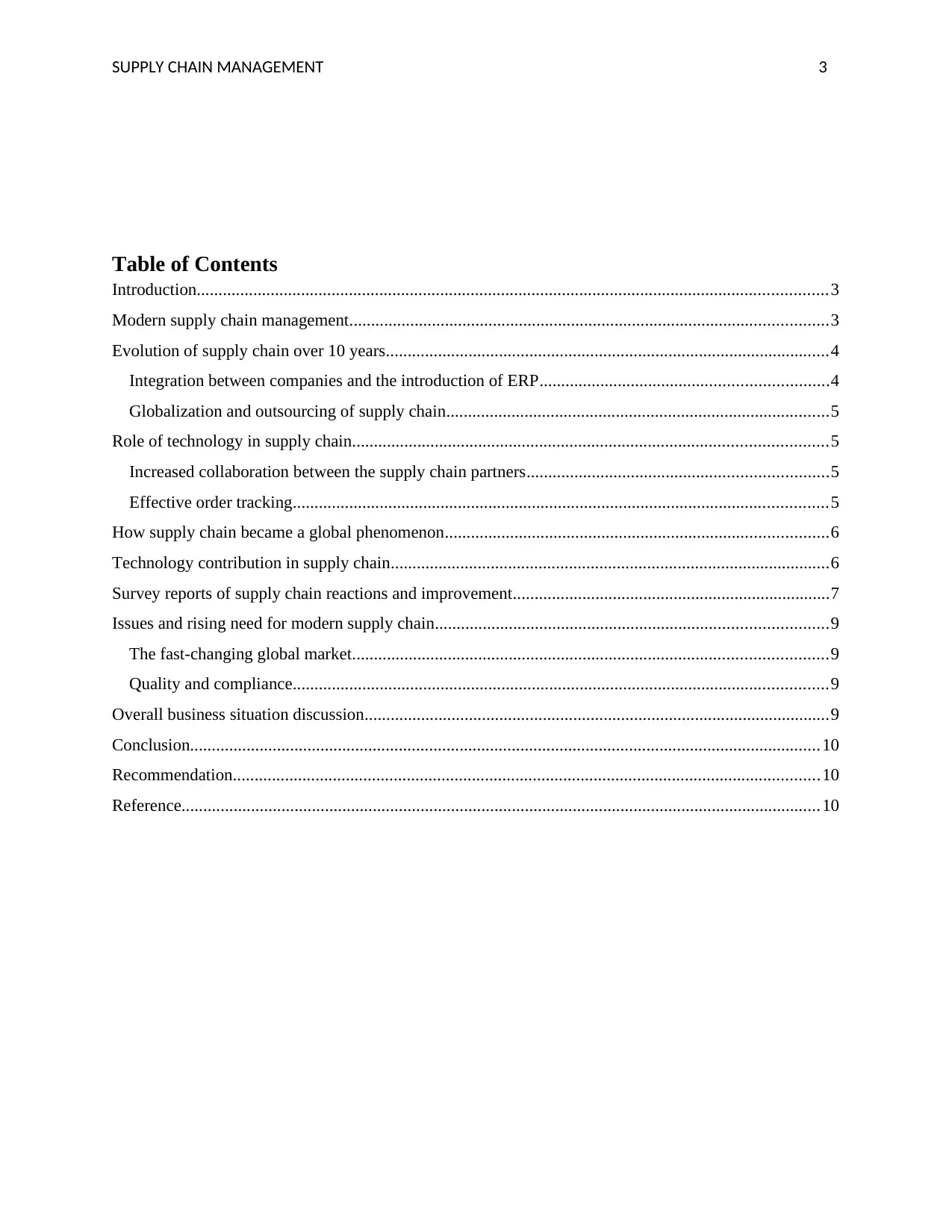
SUPPLY CHAIN MANAGEMENT 3
Table of Contents
Introduction.................................................................................................................................................3
Modern supply chain management..............................................................................................................3
Evolution of supply chain over 10 years......................................................................................................4
Integration between companies and the introduction of ERP..................................................................4
Globalization and outsourcing of supply chain........................................................................................5
Role of technology in supply chain.............................................................................................................5
Increased collaboration between the supply chain partners.....................................................................5
Effective order tracking...........................................................................................................................5
How supply chain became a global phenomenon........................................................................................6
Technology contribution in supply chain.....................................................................................................6
Survey reports of supply chain reactions and improvement.........................................................................7
Issues and rising need for modern supply chain..........................................................................................9
The fast-changing global market.............................................................................................................9
Quality and compliance...........................................................................................................................9
Overall business situation discussion...........................................................................................................9
Conclusion.................................................................................................................................................10
Recommendation.......................................................................................................................................10
Reference...................................................................................................................................................10
Table of Contents
Introduction.................................................................................................................................................3
Modern supply chain management..............................................................................................................3
Evolution of supply chain over 10 years......................................................................................................4
Integration between companies and the introduction of ERP..................................................................4
Globalization and outsourcing of supply chain........................................................................................5
Role of technology in supply chain.............................................................................................................5
Increased collaboration between the supply chain partners.....................................................................5
Effective order tracking...........................................................................................................................5
How supply chain became a global phenomenon........................................................................................6
Technology contribution in supply chain.....................................................................................................6
Survey reports of supply chain reactions and improvement.........................................................................7
Issues and rising need for modern supply chain..........................................................................................9
The fast-changing global market.............................................................................................................9
Quality and compliance...........................................................................................................................9
Overall business situation discussion...........................................................................................................9
Conclusion.................................................................................................................................................10
Recommendation.......................................................................................................................................10
Reference...................................................................................................................................................10
⊘ This is a preview!⊘
Do you want full access?
Subscribe today to unlock all pages.

Trusted by 1+ million students worldwide
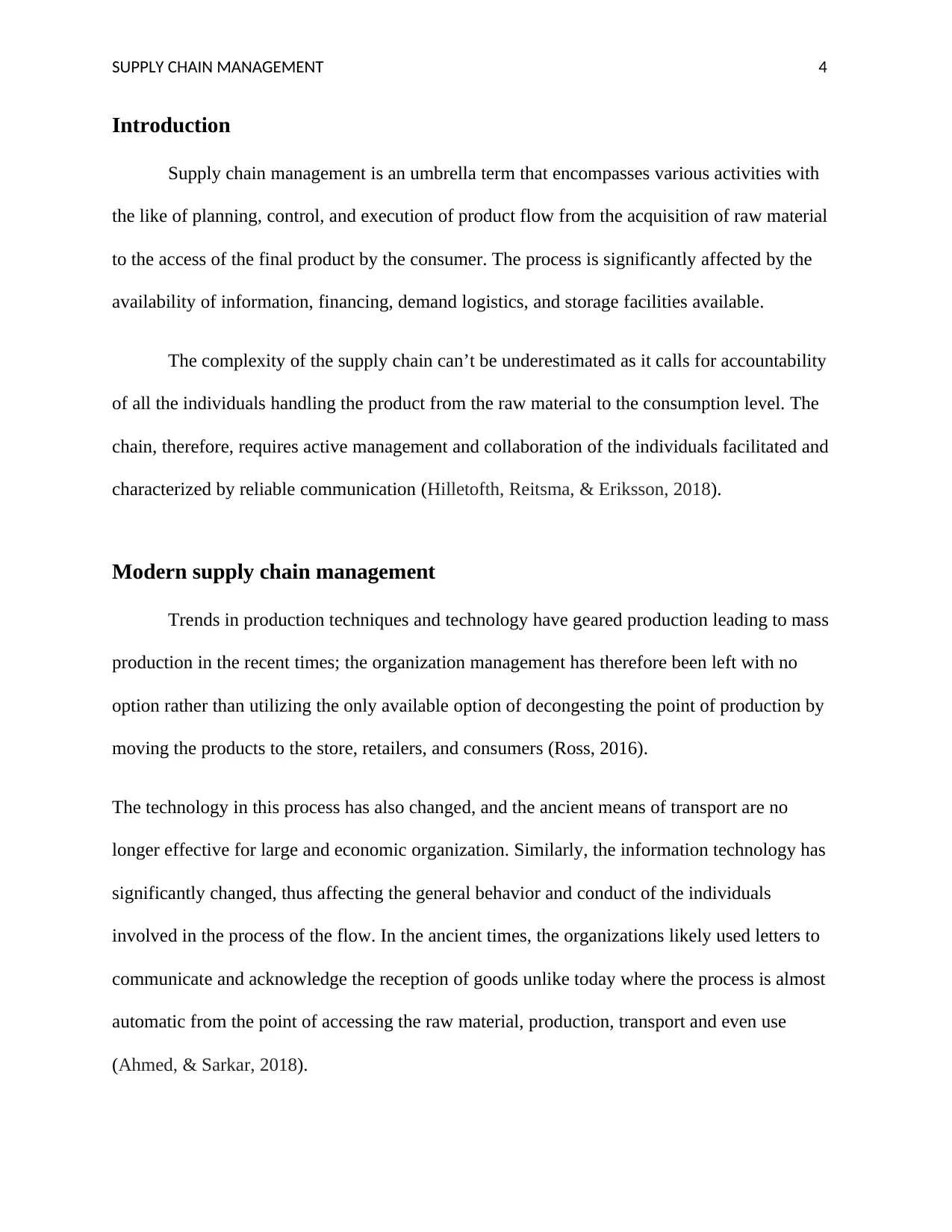
SUPPLY CHAIN MANAGEMENT 4
Introduction
Supply chain management is an umbrella term that encompasses various activities with
the like of planning, control, and execution of product flow from the acquisition of raw material
to the access of the final product by the consumer. The process is significantly affected by the
availability of information, financing, demand logistics, and storage facilities available.
The complexity of the supply chain can’t be underestimated as it calls for accountability
of all the individuals handling the product from the raw material to the consumption level. The
chain, therefore, requires active management and collaboration of the individuals facilitated and
characterized by reliable communication (Hilletofth, Reitsma, & Eriksson, 2018).
Modern supply chain management
Trends in production techniques and technology have geared production leading to mass
production in the recent times; the organization management has therefore been left with no
option rather than utilizing the only available option of decongesting the point of production by
moving the products to the store, retailers, and consumers (Ross, 2016).
The technology in this process has also changed, and the ancient means of transport are no
longer effective for large and economic organization. Similarly, the information technology has
significantly changed, thus affecting the general behavior and conduct of the individuals
involved in the process of the flow. In the ancient times, the organizations likely used letters to
communicate and acknowledge the reception of goods unlike today where the process is almost
automatic from the point of accessing the raw material, production, transport and even use
(Ahmed, & Sarkar, 2018).
Introduction
Supply chain management is an umbrella term that encompasses various activities with
the like of planning, control, and execution of product flow from the acquisition of raw material
to the access of the final product by the consumer. The process is significantly affected by the
availability of information, financing, demand logistics, and storage facilities available.
The complexity of the supply chain can’t be underestimated as it calls for accountability
of all the individuals handling the product from the raw material to the consumption level. The
chain, therefore, requires active management and collaboration of the individuals facilitated and
characterized by reliable communication (Hilletofth, Reitsma, & Eriksson, 2018).
Modern supply chain management
Trends in production techniques and technology have geared production leading to mass
production in the recent times; the organization management has therefore been left with no
option rather than utilizing the only available option of decongesting the point of production by
moving the products to the store, retailers, and consumers (Ross, 2016).
The technology in this process has also changed, and the ancient means of transport are no
longer effective for large and economic organization. Similarly, the information technology has
significantly changed, thus affecting the general behavior and conduct of the individuals
involved in the process of the flow. In the ancient times, the organizations likely used letters to
communicate and acknowledge the reception of goods unlike today where the process is almost
automatic from the point of accessing the raw material, production, transport and even use
(Ahmed, & Sarkar, 2018).
Paraphrase This Document
Need a fresh take? Get an instant paraphrase of this document with our AI Paraphraser
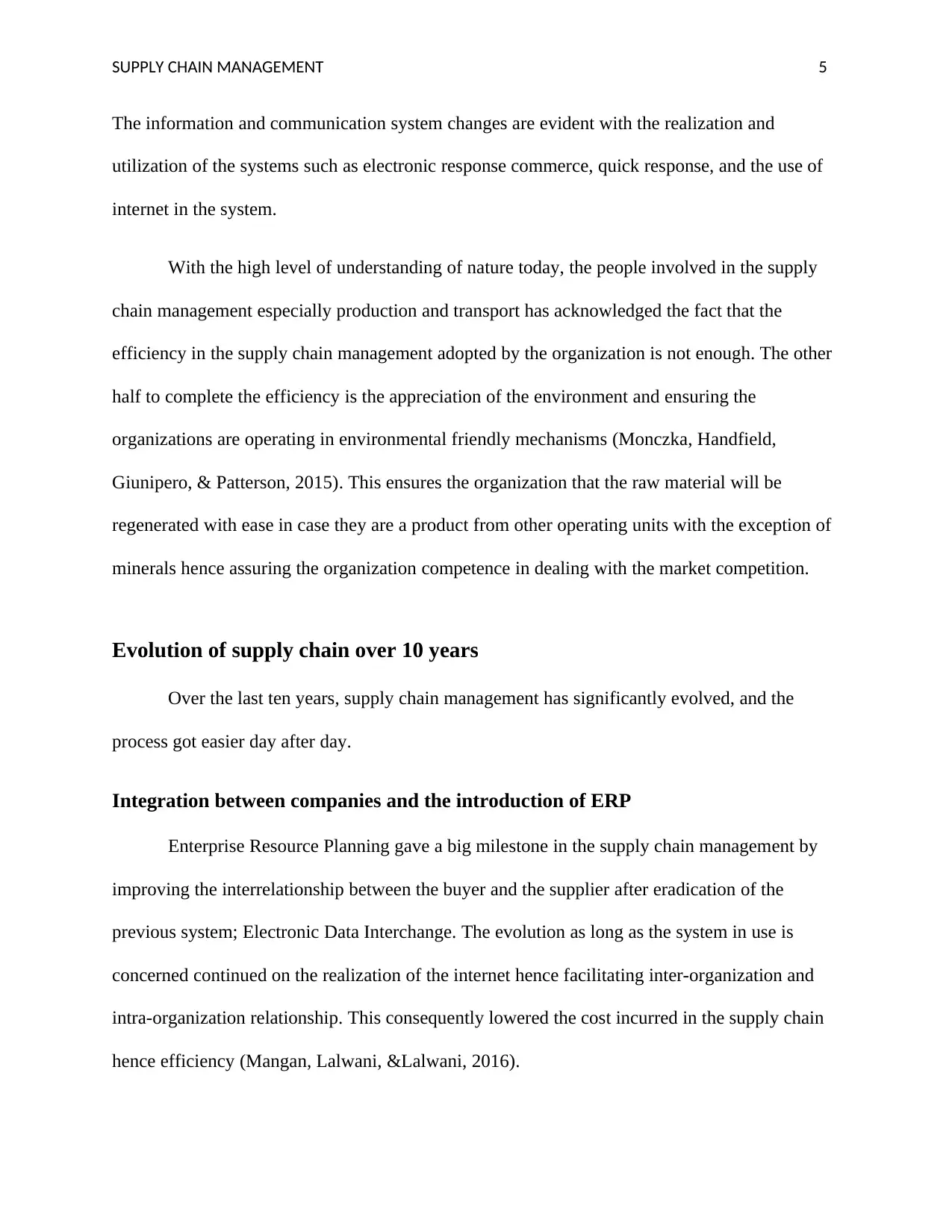
SUPPLY CHAIN MANAGEMENT 5
The information and communication system changes are evident with the realization and
utilization of the systems such as electronic response commerce, quick response, and the use of
internet in the system.
With the high level of understanding of nature today, the people involved in the supply
chain management especially production and transport has acknowledged the fact that the
efficiency in the supply chain management adopted by the organization is not enough. The other
half to complete the efficiency is the appreciation of the environment and ensuring the
organizations are operating in environmental friendly mechanisms (Monczka, Handfield,
Giunipero, & Patterson, 2015). This ensures the organization that the raw material will be
regenerated with ease in case they are a product from other operating units with the exception of
minerals hence assuring the organization competence in dealing with the market competition.
Evolution of supply chain over 10 years
Over the last ten years, supply chain management has significantly evolved, and the
process got easier day after day.
Integration between companies and the introduction of ERP
Enterprise Resource Planning gave a big milestone in the supply chain management by
improving the interrelationship between the buyer and the supplier after eradication of the
previous system; Electronic Data Interchange. The evolution as long as the system in use is
concerned continued on the realization of the internet hence facilitating inter-organization and
intra-organization relationship. This consequently lowered the cost incurred in the supply chain
hence efficiency (Mangan, Lalwani, &Lalwani, 2016).
The information and communication system changes are evident with the realization and
utilization of the systems such as electronic response commerce, quick response, and the use of
internet in the system.
With the high level of understanding of nature today, the people involved in the supply
chain management especially production and transport has acknowledged the fact that the
efficiency in the supply chain management adopted by the organization is not enough. The other
half to complete the efficiency is the appreciation of the environment and ensuring the
organizations are operating in environmental friendly mechanisms (Monczka, Handfield,
Giunipero, & Patterson, 2015). This ensures the organization that the raw material will be
regenerated with ease in case they are a product from other operating units with the exception of
minerals hence assuring the organization competence in dealing with the market competition.
Evolution of supply chain over 10 years
Over the last ten years, supply chain management has significantly evolved, and the
process got easier day after day.
Integration between companies and the introduction of ERP
Enterprise Resource Planning gave a big milestone in the supply chain management by
improving the interrelationship between the buyer and the supplier after eradication of the
previous system; Electronic Data Interchange. The evolution as long as the system in use is
concerned continued on the realization of the internet hence facilitating inter-organization and
intra-organization relationship. This consequently lowered the cost incurred in the supply chain
hence efficiency (Mangan, Lalwani, &Lalwani, 2016).

SUPPLY CHAIN MANAGEMENT 6
The interaction between the organizations has facilitated the sharing of knowledge in
locating consumers and appreciation of the environment hence its conservation. The use of the
internet has made communication and data entry as well as transfer instant and on , making it
more reliable by reducing information related losses in the supply chain.
Globalization and outsourcing of supply chain
The exploration of the transport means led to the discovery of reliable, convenient, and cost-
effective means of transport overseas. In this note, it is important to appreciate the fact that
consumers are located overseas and also the distribution of the raw material is not uniform
(Feng, Yu, Wang, Wong, Xu, & Xiao, 2018).
Role of technology in supply chain
Technology role in business and supply chain has been critical and can’t be underestimated as far
as;
Increased collaboration between the supply chain partners
The sharing of information between the suppliers is done in real time, and the partners are
able to keep track of the supply partners in the chain hence making more informed decisions.
The supplier henceforth is exposed to the knowledge of the market demand and the desired
quantity of supply hence reducing the cost of procurement through making sound decisions
(Tseng, Lim, Wu, KZhou, & Bui, 2018).
Effective order tracking
The convenience and the simplicity of the buying process are vital in determining the
possibility of redoing the business with the same customers. Technology has enabled the
The interaction between the organizations has facilitated the sharing of knowledge in
locating consumers and appreciation of the environment hence its conservation. The use of the
internet has made communication and data entry as well as transfer instant and on , making it
more reliable by reducing information related losses in the supply chain.
Globalization and outsourcing of supply chain
The exploration of the transport means led to the discovery of reliable, convenient, and cost-
effective means of transport overseas. In this note, it is important to appreciate the fact that
consumers are located overseas and also the distribution of the raw material is not uniform
(Feng, Yu, Wang, Wong, Xu, & Xiao, 2018).
Role of technology in supply chain
Technology role in business and supply chain has been critical and can’t be underestimated as far
as;
Increased collaboration between the supply chain partners
The sharing of information between the suppliers is done in real time, and the partners are
able to keep track of the supply partners in the chain hence making more informed decisions.
The supplier henceforth is exposed to the knowledge of the market demand and the desired
quantity of supply hence reducing the cost of procurement through making sound decisions
(Tseng, Lim, Wu, KZhou, & Bui, 2018).
Effective order tracking
The convenience and the simplicity of the buying process are vital in determining the
possibility of redoing the business with the same customers. Technology has enabled the
⊘ This is a preview!⊘
Do you want full access?
Subscribe today to unlock all pages.

Trusted by 1+ million students worldwide
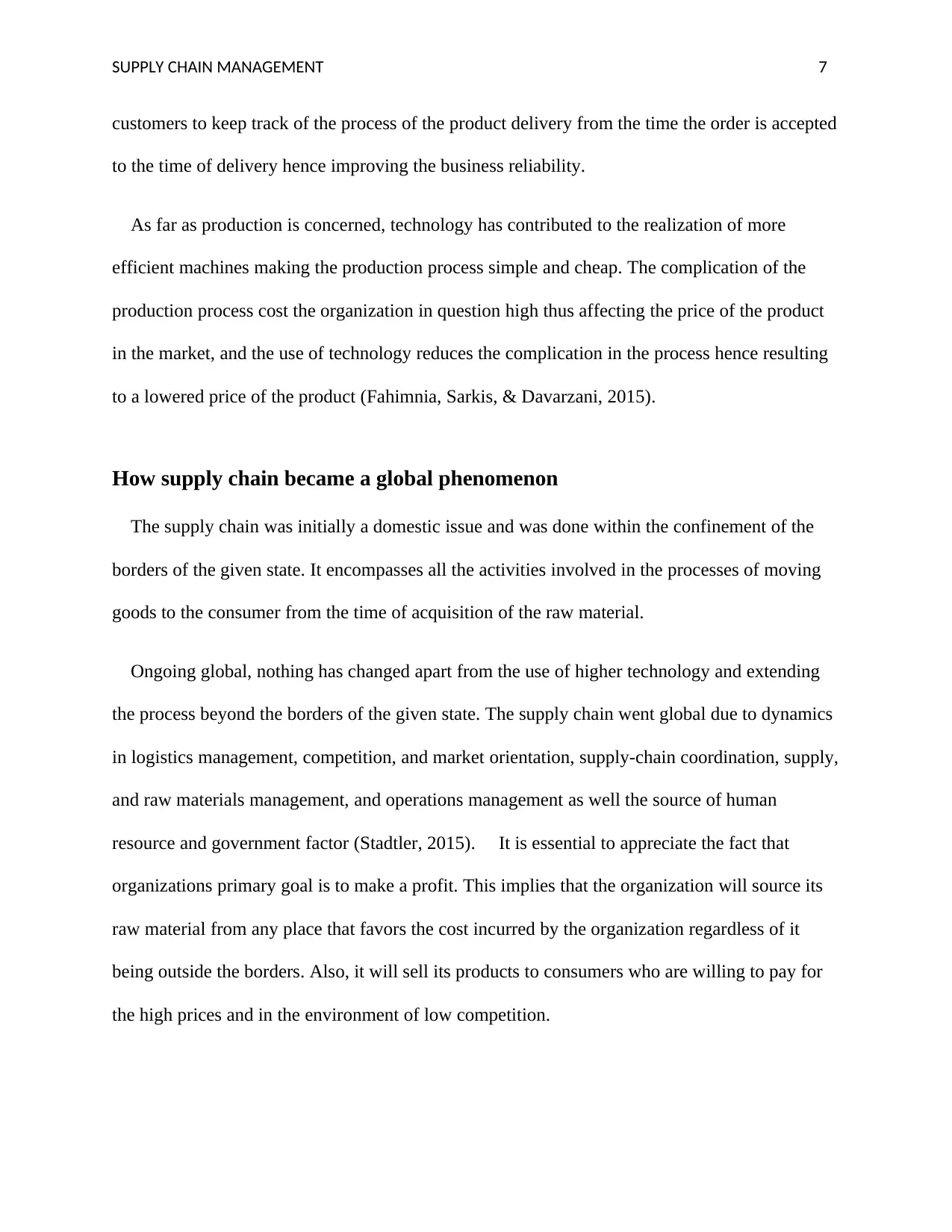
SUPPLY CHAIN MANAGEMENT 7
customers to keep track of the process of the product delivery from the time the order is accepted
to the time of delivery hence improving the business reliability.
As far as production is concerned, technology has contributed to the realization of more
efficient machines making the production process simple and cheap. The complication of the
production process cost the organization in question high thus affecting the price of the product
in the market, and the use of technology reduces the complication in the process hence resulting
to a lowered price of the product (Fahimnia, Sarkis, & Davarzani, 2015).
How supply chain became a global phenomenon
The supply chain was initially a domestic issue and was done within the confinement of the
borders of the given state. It encompasses all the activities involved in the processes of moving
goods to the consumer from the time of acquisition of the raw material.
Ongoing global, nothing has changed apart from the use of higher technology and extending
the process beyond the borders of the given state. The supply chain went global due to dynamics
in logistics management, competition, and market orientation, supply-chain coordination, supply,
and raw materials management, and operations management as well the source of human
resource and government factor (Stadtler, 2015). It is essential to appreciate the fact that
organizations primary goal is to make a profit. This implies that the organization will source its
raw material from any place that favors the cost incurred by the organization regardless of it
being outside the borders. Also, it will sell its products to consumers who are willing to pay for
the high prices and in the environment of low competition.
customers to keep track of the process of the product delivery from the time the order is accepted
to the time of delivery hence improving the business reliability.
As far as production is concerned, technology has contributed to the realization of more
efficient machines making the production process simple and cheap. The complication of the
production process cost the organization in question high thus affecting the price of the product
in the market, and the use of technology reduces the complication in the process hence resulting
to a lowered price of the product (Fahimnia, Sarkis, & Davarzani, 2015).
How supply chain became a global phenomenon
The supply chain was initially a domestic issue and was done within the confinement of the
borders of the given state. It encompasses all the activities involved in the processes of moving
goods to the consumer from the time of acquisition of the raw material.
Ongoing global, nothing has changed apart from the use of higher technology and extending
the process beyond the borders of the given state. The supply chain went global due to dynamics
in logistics management, competition, and market orientation, supply-chain coordination, supply,
and raw materials management, and operations management as well the source of human
resource and government factor (Stadtler, 2015). It is essential to appreciate the fact that
organizations primary goal is to make a profit. This implies that the organization will source its
raw material from any place that favors the cost incurred by the organization regardless of it
being outside the borders. Also, it will sell its products to consumers who are willing to pay for
the high prices and in the environment of low competition.
Paraphrase This Document
Need a fresh take? Get an instant paraphrase of this document with our AI Paraphraser
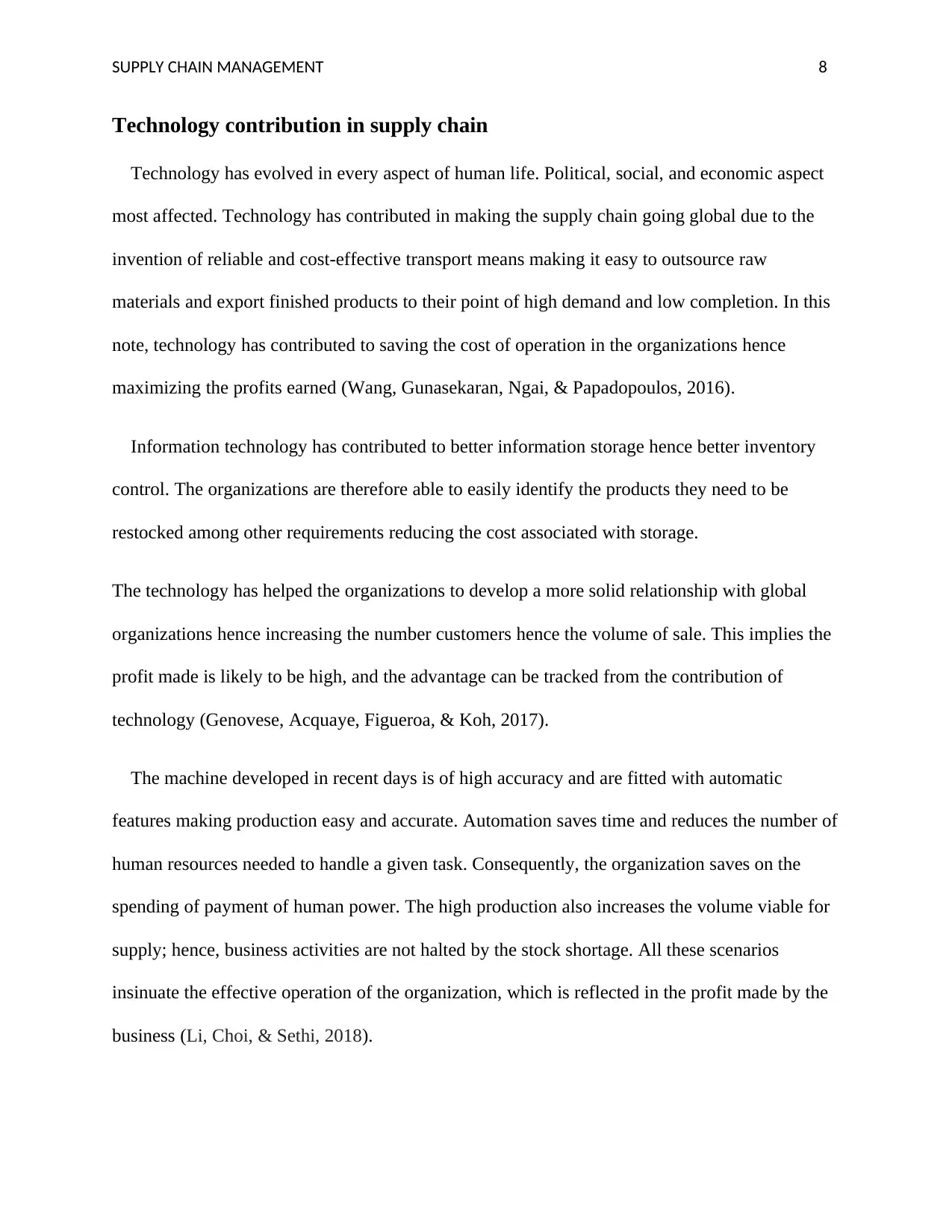
SUPPLY CHAIN MANAGEMENT 8
Technology contribution in supply chain
Technology has evolved in every aspect of human life. Political, social, and economic aspect
most affected. Technology has contributed in making the supply chain going global due to the
invention of reliable and cost-effective transport means making it easy to outsource raw
materials and export finished products to their point of high demand and low completion. In this
note, technology has contributed to saving the cost of operation in the organizations hence
maximizing the profits earned (Wang, Gunasekaran, Ngai, & Papadopoulos, 2016).
Information technology has contributed to better information storage hence better inventory
control. The organizations are therefore able to easily identify the products they need to be
restocked among other requirements reducing the cost associated with storage.
The technology has helped the organizations to develop a more solid relationship with global
organizations hence increasing the number customers hence the volume of sale. This implies the
profit made is likely to be high, and the advantage can be tracked from the contribution of
technology (Genovese, Acquaye, Figueroa, & Koh, 2017).
The machine developed in recent days is of high accuracy and are fitted with automatic
features making production easy and accurate. Automation saves time and reduces the number of
human resources needed to handle a given task. Consequently, the organization saves on the
spending of payment of human power. The high production also increases the volume viable for
supply; hence, business activities are not halted by the stock shortage. All these scenarios
insinuate the effective operation of the organization, which is reflected in the profit made by the
business (Li, Choi, & Sethi, 2018).
Technology contribution in supply chain
Technology has evolved in every aspect of human life. Political, social, and economic aspect
most affected. Technology has contributed in making the supply chain going global due to the
invention of reliable and cost-effective transport means making it easy to outsource raw
materials and export finished products to their point of high demand and low completion. In this
note, technology has contributed to saving the cost of operation in the organizations hence
maximizing the profits earned (Wang, Gunasekaran, Ngai, & Papadopoulos, 2016).
Information technology has contributed to better information storage hence better inventory
control. The organizations are therefore able to easily identify the products they need to be
restocked among other requirements reducing the cost associated with storage.
The technology has helped the organizations to develop a more solid relationship with global
organizations hence increasing the number customers hence the volume of sale. This implies the
profit made is likely to be high, and the advantage can be tracked from the contribution of
technology (Genovese, Acquaye, Figueroa, & Koh, 2017).
The machine developed in recent days is of high accuracy and are fitted with automatic
features making production easy and accurate. Automation saves time and reduces the number of
human resources needed to handle a given task. Consequently, the organization saves on the
spending of payment of human power. The high production also increases the volume viable for
supply; hence, business activities are not halted by the stock shortage. All these scenarios
insinuate the effective operation of the organization, which is reflected in the profit made by the
business (Li, Choi, & Sethi, 2018).
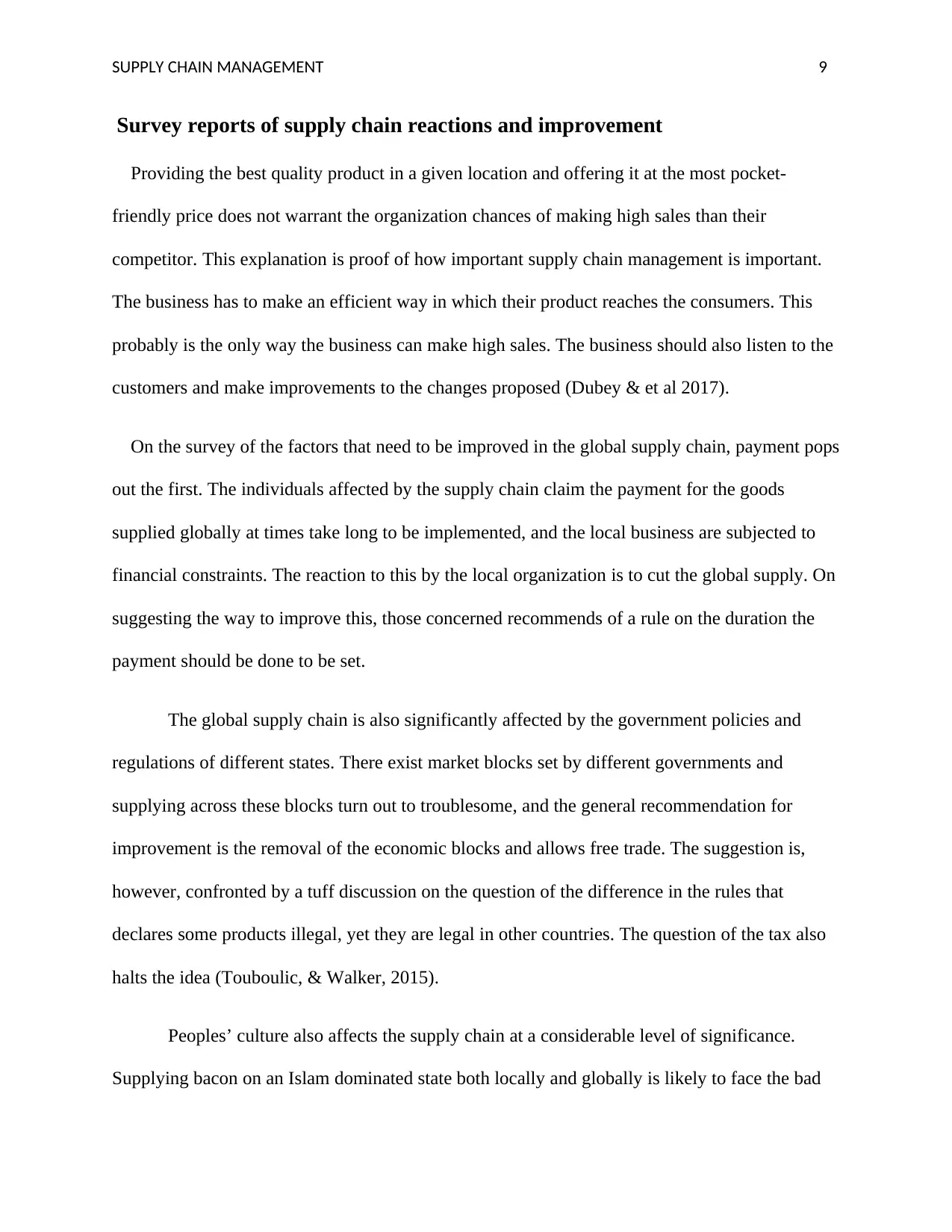
SUPPLY CHAIN MANAGEMENT 9
Survey reports of supply chain reactions and improvement
Providing the best quality product in a given location and offering it at the most pocket-
friendly price does not warrant the organization chances of making high sales than their
competitor. This explanation is proof of how important supply chain management is important.
The business has to make an efficient way in which their product reaches the consumers. This
probably is the only way the business can make high sales. The business should also listen to the
customers and make improvements to the changes proposed (Dubey & et al 2017).
On the survey of the factors that need to be improved in the global supply chain, payment pops
out the first. The individuals affected by the supply chain claim the payment for the goods
supplied globally at times take long to be implemented, and the local business are subjected to
financial constraints. The reaction to this by the local organization is to cut the global supply. On
suggesting the way to improve this, those concerned recommends of a rule on the duration the
payment should be done to be set.
The global supply chain is also significantly affected by the government policies and
regulations of different states. There exist market blocks set by different governments and
supplying across these blocks turn out to troublesome, and the general recommendation for
improvement is the removal of the economic blocks and allows free trade. The suggestion is,
however, confronted by a tuff discussion on the question of the difference in the rules that
declares some products illegal, yet they are legal in other countries. The question of the tax also
halts the idea (Touboulic, & Walker, 2015).
Peoples’ culture also affects the supply chain at a considerable level of significance.
Supplying bacon on an Islam dominated state both locally and globally is likely to face the bad
Survey reports of supply chain reactions and improvement
Providing the best quality product in a given location and offering it at the most pocket-
friendly price does not warrant the organization chances of making high sales than their
competitor. This explanation is proof of how important supply chain management is important.
The business has to make an efficient way in which their product reaches the consumers. This
probably is the only way the business can make high sales. The business should also listen to the
customers and make improvements to the changes proposed (Dubey & et al 2017).
On the survey of the factors that need to be improved in the global supply chain, payment pops
out the first. The individuals affected by the supply chain claim the payment for the goods
supplied globally at times take long to be implemented, and the local business are subjected to
financial constraints. The reaction to this by the local organization is to cut the global supply. On
suggesting the way to improve this, those concerned recommends of a rule on the duration the
payment should be done to be set.
The global supply chain is also significantly affected by the government policies and
regulations of different states. There exist market blocks set by different governments and
supplying across these blocks turn out to troublesome, and the general recommendation for
improvement is the removal of the economic blocks and allows free trade. The suggestion is,
however, confronted by a tuff discussion on the question of the difference in the rules that
declares some products illegal, yet they are legal in other countries. The question of the tax also
halts the idea (Touboulic, & Walker, 2015).
Peoples’ culture also affects the supply chain at a considerable level of significance.
Supplying bacon on an Islam dominated state both locally and globally is likely to face the bad
⊘ This is a preview!⊘
Do you want full access?
Subscribe today to unlock all pages.

Trusted by 1+ million students worldwide
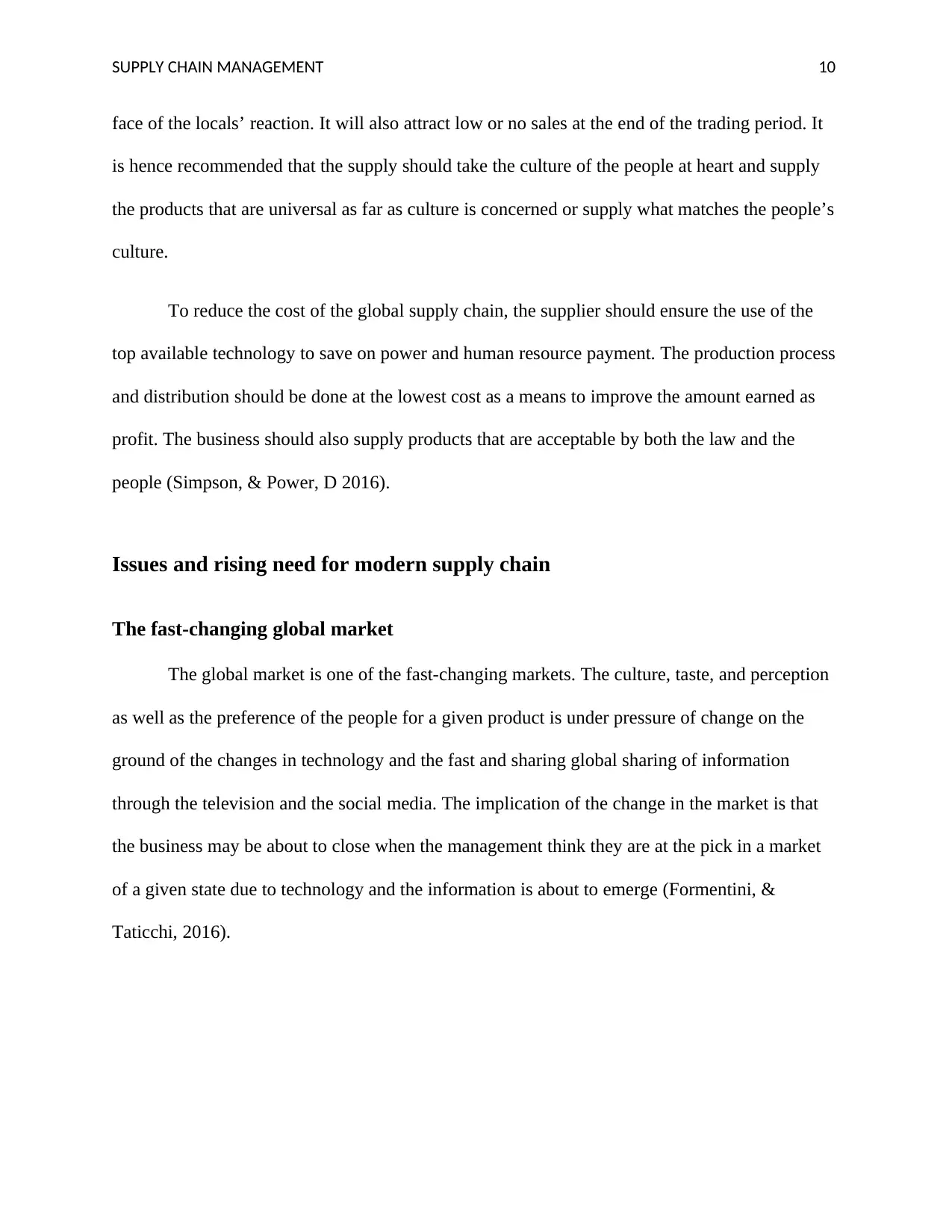
SUPPLY CHAIN MANAGEMENT 10
face of the locals’ reaction. It will also attract low or no sales at the end of the trading period. It
is hence recommended that the supply should take the culture of the people at heart and supply
the products that are universal as far as culture is concerned or supply what matches the people’s
culture.
To reduce the cost of the global supply chain, the supplier should ensure the use of the
top available technology to save on power and human resource payment. The production process
and distribution should be done at the lowest cost as a means to improve the amount earned as
profit. The business should also supply products that are acceptable by both the law and the
people (Simpson, & Power, D 2016).
Issues and rising need for modern supply chain
The fast-changing global market
The global market is one of the fast-changing markets. The culture, taste, and perception
as well as the preference of the people for a given product is under pressure of change on the
ground of the changes in technology and the fast and sharing global sharing of information
through the television and the social media. The implication of the change in the market is that
the business may be about to close when the management think they are at the pick in a market
of a given state due to technology and the information is about to emerge (Formentini, &
Taticchi, 2016).
face of the locals’ reaction. It will also attract low or no sales at the end of the trading period. It
is hence recommended that the supply should take the culture of the people at heart and supply
the products that are universal as far as culture is concerned or supply what matches the people’s
culture.
To reduce the cost of the global supply chain, the supplier should ensure the use of the
top available technology to save on power and human resource payment. The production process
and distribution should be done at the lowest cost as a means to improve the amount earned as
profit. The business should also supply products that are acceptable by both the law and the
people (Simpson, & Power, D 2016).
Issues and rising need for modern supply chain
The fast-changing global market
The global market is one of the fast-changing markets. The culture, taste, and perception
as well as the preference of the people for a given product is under pressure of change on the
ground of the changes in technology and the fast and sharing global sharing of information
through the television and the social media. The implication of the change in the market is that
the business may be about to close when the management think they are at the pick in a market
of a given state due to technology and the information is about to emerge (Formentini, &
Taticchi, 2016).
Paraphrase This Document
Need a fresh take? Get an instant paraphrase of this document with our AI Paraphraser
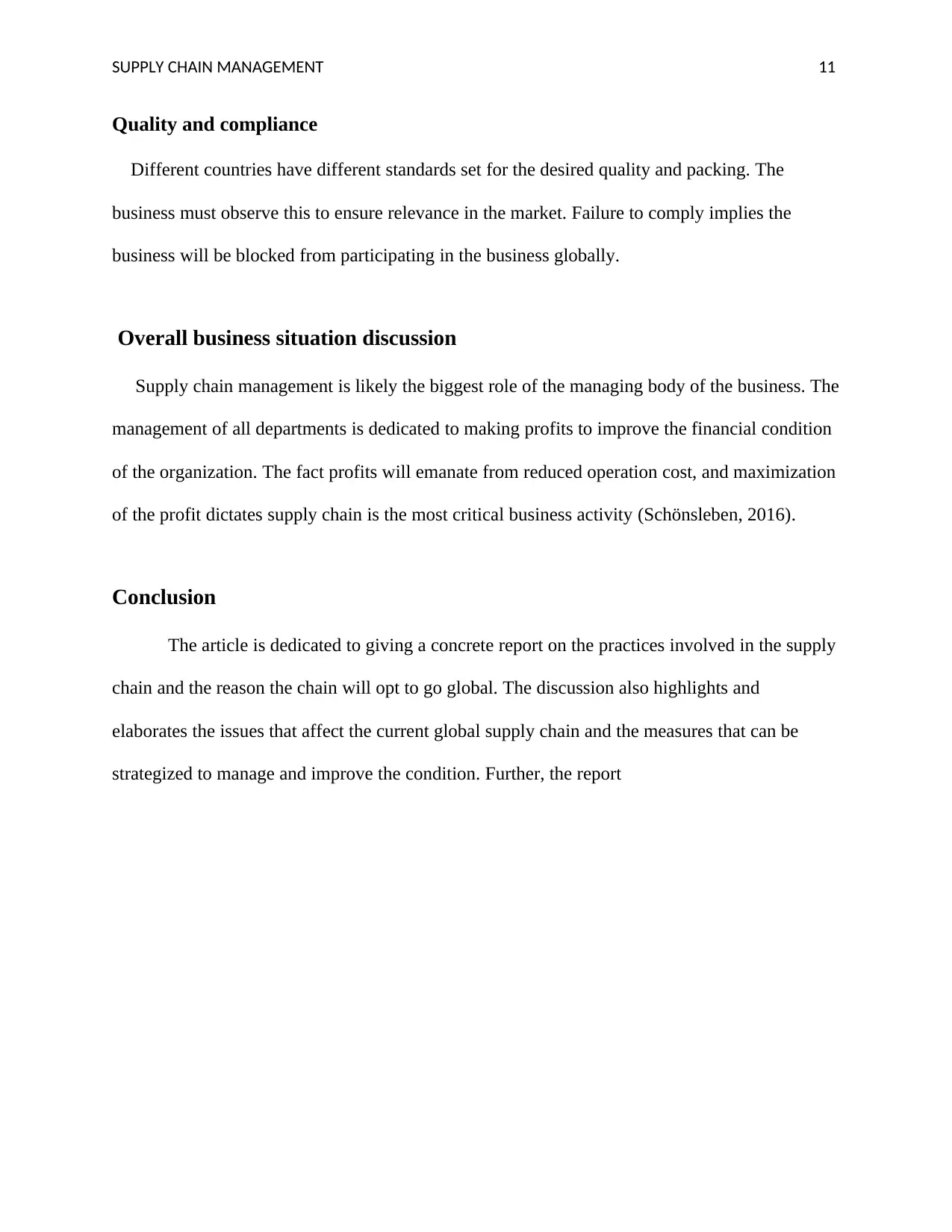
SUPPLY CHAIN MANAGEMENT 11
Quality and compliance
Different countries have different standards set for the desired quality and packing. The
business must observe this to ensure relevance in the market. Failure to comply implies the
business will be blocked from participating in the business globally.
Overall business situation discussion
Supply chain management is likely the biggest role of the managing body of the business. The
management of all departments is dedicated to making profits to improve the financial condition
of the organization. The fact profits will emanate from reduced operation cost, and maximization
of the profit dictates supply chain is the most critical business activity (Schönsleben, 2016).
Conclusion
The article is dedicated to giving a concrete report on the practices involved in the supply
chain and the reason the chain will opt to go global. The discussion also highlights and
elaborates the issues that affect the current global supply chain and the measures that can be
strategized to manage and improve the condition. Further, the report
Quality and compliance
Different countries have different standards set for the desired quality and packing. The
business must observe this to ensure relevance in the market. Failure to comply implies the
business will be blocked from participating in the business globally.
Overall business situation discussion
Supply chain management is likely the biggest role of the managing body of the business. The
management of all departments is dedicated to making profits to improve the financial condition
of the organization. The fact profits will emanate from reduced operation cost, and maximization
of the profit dictates supply chain is the most critical business activity (Schönsleben, 2016).
Conclusion
The article is dedicated to giving a concrete report on the practices involved in the supply
chain and the reason the chain will opt to go global. The discussion also highlights and
elaborates the issues that affect the current global supply chain and the measures that can be
strategized to manage and improve the condition. Further, the report

SUPPLY CHAIN MANAGEMENT 12
Recommendation
Business organizations are encouraged to adopt the global supply chain. Going global will save
the organization operation cost on access to raw material on lower prices from the countries
favored by climate to produce the raw materials. The second recommendation to the business
organization’s supply chain is to embrace the technology in existence to ease the processes and
save the organization from high expenses.
Recommendation
Business organizations are encouraged to adopt the global supply chain. Going global will save
the organization operation cost on access to raw material on lower prices from the countries
favored by climate to produce the raw materials. The second recommendation to the business
organization’s supply chain is to embrace the technology in existence to ease the processes and
save the organization from high expenses.
⊘ This is a preview!⊘
Do you want full access?
Subscribe today to unlock all pages.

Trusted by 1+ million students worldwide
1 out of 15
Related Documents
Your All-in-One AI-Powered Toolkit for Academic Success.
+13062052269
info@desklib.com
Available 24*7 on WhatsApp / Email
![[object Object]](/_next/static/media/star-bottom.7253800d.svg)
Unlock your academic potential
Copyright © 2020–2025 A2Z Services. All Rights Reserved. Developed and managed by ZUCOL.





